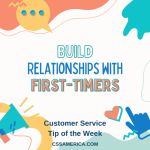A quarter is a very interesting thing. A quarter can be a form of money. A quarter is a time period where public companies report their financials. A quarter is the portion of the pro football schedule where most coaches have divided up their season into four sets of four games each. They do this to best approach a segment of their schedule as well as analyze that segment.
To a business, when it comes to customer retention and growth, a quarter should be equally of interest.
When you are assessing the performance of your business as it relates to customer service, satisfaction, loyalty, and retention-driven growth, you need to also think of your measurements in terms of quarters. Those measures can come in the form of mystery shopping, satisfaction surveys, or focus groups. No matter in what form they come, you need to be evaluating your customer satisfaction at a minimum on a quarterly basis.
Keep in mind that customer satisfaction is driven in any organization by three factors:
- The Attitudes, Skills, and Knowledge of the employees
- The Processes within which the customers experience your organization
- The Products and Services themselves.
So on a quarterly basis, you need to be assessing, analyzing, and addressing these keys to customer satisfaction and loyalty just as you would any other set of key metrics in your business.
Through the different methods of acquiring customer data as referenced previously, and including assessments of internal operational service metrics such as process times, wait times, queue times, first contact resolution, etc., you should have a dashboard of metrics that enables you to quickly see trends in satisfaction, loyalty, and growth.
If you always want to be able to make data-driven decisions that are the best for your company’s future performance, make sure you have hard numbers on such metrics as satisfaction with Attitudes, Processes, and Products. Make sure you have hard metrics on customer retention rates or attrition rates. Make sure you have hard metrics on average purchases per customer and frequency of visits. Make sure you have hard metrics on referral rates from existing customers, and make sure you have hard metrics on the financial impact of each customer to your organization’s bottom line.
You need to manage the biggest component of your top line financials (the customer) at least as well as you manage all those detailed accounts on the expense side of the ledger. Create and utilize customer retention and growth metrics to help guide your company’s planning and performance improvement initiatives.
Interested in improving your company’s customer service? See more information at: http://www.cssamerica.com/





















